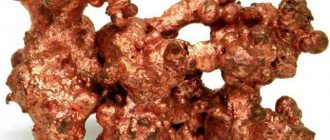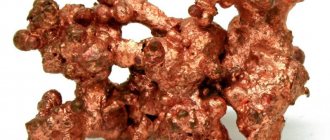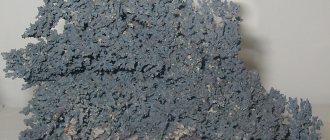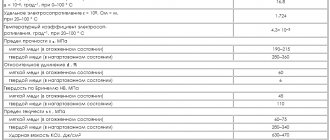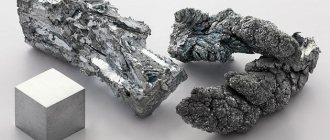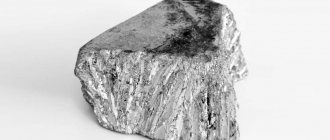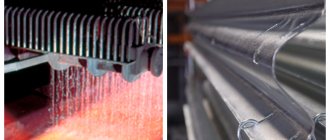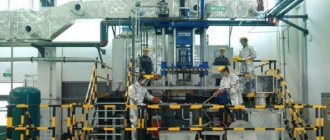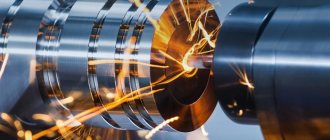Native copper measuring about 4 cm
Copper
- a mineral from the class of native elements. Fe, Ag, Au, As and other elements are found in natural minerals as impurities or forming solid solutions with Cu. The simple substance copper is a ductile transition metal of golden-pink color (pink in the absence of an oxide film). One of the first metals widely mastered by man due to its relative availability for extraction from ore and low melting point. It is one of the seven metals known to man since very ancient times. Copper is an essential element for all higher plants and animals.
- Structure
- Properties
- Reserves and production
- Origin
- Application
- Classification
- Physical properties
- Optical properties
- Crystallographic properties
See also:
Gold
– structure and physical properties
Aluminum
– structure and physical properties
STRUCTURE
Crystal structure of copper
Cubic system, hexaoctahedral type of m3m symmetry, crystal structure – cubic face-centered lattice. The model is a cube of eight atoms in the corners and six atoms located in the center of the faces (6 faces). Each atom of a given crystal lattice has a coordination number of 12. Native copper occurs in the form of plates, spongy and solid masses, thread-like and wire-like aggregates, as well as crystals, complex twins, skeletal crystals and dendrites. The surface is often covered with films of “copper green” (malachite), “copper blue” (azurite), copper phosphates and other products of its secondary alteration.
The value of copper for humans
Copper is one of the most important microelements not only for plants. It is found in the human body (100-200 mg) and is produced by the liver. To maintain balance, a person should consume 2 mg of copper daily. Excess mineral turns into poison, because of this you should not cook food in copper utensils.
The benefits of copper cannot be overestimated when it comes to wound healing and body restoration. It has bactericidal properties, helps normalize the functioning of the circulatory system, tissue regeneration, and is used as a component for some medications. In 2 hours, all microbes die on a copper surface, so it is planned to make railings, locks and door handles from this metal for hospitals and other public places.
Copper bracelets and amulets were worn in ancient times not for decoration, but to maintain health. For the same purpose, with the help of nanotechnology, bed and underwear with copper threads were created. It has a beneficial effect on the skin, blood vessels, central nervous system, and musculoskeletal system.
If we analyze the importance of copper and its widespread use, we can say that the copper age continues.
PROPERTIES
Native copper crystals, Lake Superior, Kinawee County, Michigan, USA. Size 12 x 8.5 cm
Copper is a golden-pink ductile metal; in air it quickly becomes covered with an oxide film, which gives it a characteristic intense yellowish-red hue. Thin films of copper have a greenish-blue color when exposed to light.
Along with osmium, cesium and gold, copper is one of the four metals that have a distinct coloration that is different from the gray or silver of other metals. This color tint is explained by the presence of electronic transitions between the filled third and half-empty fourth atomic orbitals: the energy difference between them corresponds to the wavelength of orange light. The same mechanism is responsible for the characteristic color of gold.
Copper has high thermal and electrical conductivity (it ranks second in electrical conductivity among metals after silver). Specific electrical conductivity at 20 °C: 55.5-58 MS/m. Copper has a relatively large temperature coefficient of resistance: 0.4%/°C and is weakly dependent on temperature over a wide temperature range. Copper is diamagnetic.
There are a number of copper alloys: brass - with zinc, bronze - with tin and other elements, cupronickel - with nickel and others.
Copper grades
Copper marking begins with the letter "M" . The number following it shows the purity of the metal:
- MOO: 99.99% Cu;
- MO: 99.97%;
- M1: 99.9%;
- M2: 99.7%;
- M3: 99.5%;
- M4: 99%.
Oxygen significantly reduces the strength of copper, so its content is implied in the marking. Brands with numbers 1, 2, 3 contain 0.5-0.8% oxygen, MO - 0.02%, MOb - 0%. The presence of phosphorus is indicated by the letters “p” (at a small percentage) and “f” (more than 0.4%). The letter "k" refers to copper cathode. Some countries have adopted their own labeling that does not correspond to the Russian one.
There are 2 types of copper – pure and technical. The latter is used for the production of semi-finished products and smelting of alloys. Impurities of other chemical elements to one degree or another affect the properties of Cu. For example:
- Nickel reduces thermal conductivity, and tin enhances it.
- Bismuth worsens the technical characteristics, and arsenic neutralizes the effect of the former, remaining neutral with respect to copper.
- Antimony and silicon reduce the ability to conduct heat and electricity.
- Sulfur and selenium in certain quantities impair plasticity.
- Lead and bismuth make pressure processing difficult.
- Phosphorus removes oxygen, which causes physical properties to deteriorate.
- Impurities such as zinc, manganese, arsenic, nickel, and silver practically do not change the physical characteristics of copper.
RESERVES AND PRODUCTION
Copper specimen, 13.6 cm. Kinawi Peninsula, Michigan, USA
The average copper content in the earth's crust (clarke) is (4.7-5.5) 10−3% (by mass). In sea and river water the copper content is much lower: 3·10−7% and 10−7% (by weight), respectively. Most copper ore is mined by open pit mining. The copper content in the ore ranges from 0.3 to 1.0%. World reserves in 2000 were, according to experts, 954 million tons, of which 687 million tons were proven reserves; Russia accounted for 3.2% of total and 3.1% of confirmed world reserves. Thus, at the current rate of consumption, copper reserves will last approximately 60 years. Copper is obtained from copper ores and minerals. The main methods for obtaining copper are pyrometallurgy, hydrometallurgy and electrolysis. The pyrometallurgical method involves obtaining copper from sulfide ores, for example, chalcopyrite CuFeS2. The hydrometallurgical method involves dissolving copper minerals in dilute sulfuric acid or ammonia solution; From the resulting solutions, copper is replaced by metallic iron.
Answers to user questions about copper
We will answer several popular questions from users.
Do old TVs have copper?
From 1 old TV you can get from one and a half to two kilograms of copper. This is mainly the winding of transformers and coils.
What is the electronic and electron graphic formula of copper?
Regarding the electronic configuration of the copper atom: 1s2 2s2 2p6 3s2 3p6 3d10 4s1
Graphic formula of copper:
ORIGIN
Small nugget of copper
Typically, native copper is formed in the oxidation zone of some copper sulfide deposits in association with calcite, native silver, cuprite, malachite, azurite, brochantite and other minerals. The masses of individual clusters of native copper reach 400 tons. Large industrial deposits of native copper, along with other copper-containing minerals, are formed when volcanic rocks (diabases, melaphyres) are exposed to hydrothermal solutions, volcanic vapors and gases enriched in volatile copper compounds (for example, the Lake Superior deposit, USA). Native copper is also found in sedimentary rocks, mainly in cuprous sandstones and shales. The most famous deposits of native copper are the Turin mines (Urals), Dzhezkazgan (Kazakhstan), in the USA (on the Keweenaw Peninsula, in the states of Arizona and Utah).
History of discovery
The most ancient copper products were found in the territory of modern Turkey. They were located in the ruins of the settlement of Çatalhöyük. After the Stone Age came the Copper Age. Scientists in the 20th century were able to prove that with the help of tools made of copper, materials can be processed faster.
Alloys with tin, called bronze, were made from copper. They were used to create jewelry, tools, and weapons. When bronze gained great popularity, the Bronze Age began, which replaced the Copper Age.
The first large mines were found in Cyprus. They were developed around 3000 BC. e. In Russia, the oldest mines date back to 2000 BC. e.
Industrial smelting of copper ingots was developed in the 13th–14th centuries. In Moscow in the 15th century, the Cannon Yard was founded, which produced guns and ammunition from bronze.
APPLICATION
Copper bracelets
Due to its low resistivity, copper is widely used in electrical engineering for the manufacture of power cables, wires or other conductors, for example, in printed circuit wiring. Copper wires, in turn, are also used in the windings of energy-saving electric drives and power transformers. Another useful quality of copper is its high thermal conductivity. This allows it to be used in various heat removal devices and heat exchangers, which include well-known radiators for cooling, air conditioning and heating. Alloys using copper are widely used in various fields of technology, the most widespread of which are the above-mentioned bronze and brass. Both alloys are general names for a whole family of materials, which in addition to tin and zinc may include nickel, bismuth and other metals. In jewelry, alloys of copper and gold are often used to increase the resistance of products to deformation and abrasion, since pure gold is a very soft metal and is not resistant to these mechanical influences. The predicted new mass use of copper promises to be its use as bactericidal surfaces in medical institutions to reduce intra-hospital bacterial transfer: doors, handles, water stop valves, railings, bed rails, table tops - all surfaces touched by the human hand.
Copper – Cu
| Molecular weight | 63.55 g/mol |
| origin of name | From the Greek “Kyprium”, that is, “Cypriot metal”, after the name of the island of Cyprus |
| IMA status | valid, first described before 1959 (before IMA) |
What is copper
Even schoolchildren can tell about copper: what substance it is, what color it is, what is made from it. In the periodic table, this chemical element is designated by the symbol Cu; it is located in the 11th group of the 4th period under No. 29. The closest neighbors are gold and silver. In English, copper is called copper, in Latin - “Cuprum”, in honor of the island of Cyprus, where large deposits of this substance were found. The origin of the Russian name is unknown.
A brief explanation of what copper is is as follows: it is a transitional soft metal of red-pink color, with atomic number 29.
PHYSICAL PROPERTIES
| Mineral color | copper-red, fading to black or green in air |
| Stroke color | copper red |
| Transparency | opaque |
| Shine | metal |
| Cleavage | No |
| Hardness (Mohs scale) | 2,5-3 |
| Strength | malleable |
| Kink | jagged |
| Density (measured) | 8.94 – 8.95 g/cm3 |
| Radioactivity (GRapi) | 0 |
| Magnetism | diamagnetic |
Alloys
Pure copper is not always used in industry. To change the technical characteristics of non-ferrous metal, various components are added to it. The result is alloys that have a copper base. The most common:
- Bronze - Made by adding tin.
- Brass is made from a copper base to which zinc is added.
These are not all compounds where copper is the main component.
Bronze figurine
CRYSTALLOGRAPHIC PROPERTIES
| Point group | m3m (4/m 3 2/m) – hexoctahedral |
| Space group | Fm3m (F4/m 3 2/m) |
| singonia | cubic |
| Cell Options | a = 3.615Å |
| Morphology | cubes, dodecahedrons and tetrahexahedrons; rarely octahedra and complex combinations; thread-like, tree-like |
| Twinning | {111} twins according to the spinel law |
Processing methods
Mechanical processing can be done by:
- Broaches. A technological process used in the manufacture of wires and wires of different diameters. An extruder mechanism is used for production.
- Rolling. Technological process for the production of flat copper products. The workpieces are rolled through a machine with movable rollers.
- Polishing. To give copper products a characteristic metallic shine, felt and fabric discs are used.
- Grinding. It is used to remove a certain layer of metal, clean it from plaque and dirt. Grinding is carried out using abrasives.
The turning method of processing copper blanks also deserves attention. It is used to manufacture washers, studs, fittings, bushings, and flanges.
Copper is a sought-after non-ferrous metal with good physical and chemical properties. The metal is suitable for making jewelry, parts of industrial machines, household appliances, and radio components.
Purity
Oxygen-free copper OFC has different degrees of purity. The purity of the metal is indicated as follows: “*N”. In place of the asterisk (*), insert a number that reveals information about the number of nines after the decimal point. Thus, the OFC 6N grade of oxygen-free copper reports that it contains 99.999999% pure metal. The amount of foreign impurities is 0.000001%.
The first production of 6N grade copper was carried out in 1985 in Japan by Nippon Mining Co. Highly purified oxygen-free copper went into mass production in 1987. The main areas of application then became acoustic wires and interconnect network cables.
Currently, such pure copper is produced by quite a lot of manufacturers in the world, including in the Russian Federation.
Some companies claim that they have achieved a degree of purification higher than 6 -7N, 8N, etc. But it should be taken into account that at present there is no unity in determining standards for the purity of oxygen-free copper and its quality. In some cases, the presence of any impurities is simply not taken into account. Typically, such foreign inclusions include silver.

